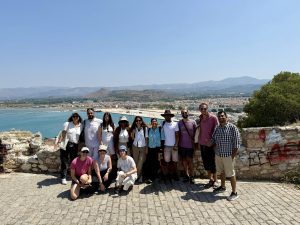Tag Archives: Digital Heritage
Digital Tools Summer School Programme
From 12th May to 18th June, HERITΛGE hosted its Digital Tools Summer School programme, bringing together 24 participants from Africa, Asia, and Europe.* The programme combined online and in-person training and equipped heritage professionals with practical skills in GIS, photogrammetry, 3D modelling, and terrestrial laser scanning.
From 12 May – 6 June the trainees took part in an online Training Program, while from 8 – 18 June those attending the Field School on the ground worked with trainer Cornelis Stahl in and around teh two of Nafplio, in the historic region of Argolida in Greece.
The Summer School engaged with 21 capacity building cases from across the globe, involving museums, universities, heritage organisations, and architectural firms. Institutions included the Khama III Memorial Museum in Botswana, the Uganda National Museum, the National Museums and Monuments of Zimbabwe, and the Ethiopian Heritage Authority, as well as international organisations such as UNESCO and the World Monuments Fund. Universities including Addis Ababa University, the University of Cologne, and the University of Lincoln also contributed to the knowledge exchange. These cases reflected a wide spectrum of heritage practice, from community-based hubs to global conservation bodies.
Geographic Information Systems (GIS)
The first module introduced Geographic Information Systems (GIS). Over two weeks, participants explored the use of open-source software QGIS to manage and analyse cultural heritage data. They learned how to source and style datasets, georeference manuscript maps, create new spatial data, and apply geoprocessing tools such as buffers and intersections. By the end of the module, each participant had produced a map tailored to their own heritage project, demonstrating their ability to use GIS to present and analyse spatial data.
Photogrammetry and 3D Modelling
The second module focused on photogrammetry. In a week and a half, participants developed skills in image-based 3D reconstruction, creating orthophotos and point clouds using Agisoft Metashape Professional. Combining photography, computer vision, and GIS, they produced 3D models that will aid in heritage documentation, monitoring, and communication. This workflow allowed participants to cover the full cycle from image acquisition through data processing to model publishing.
On-site 3D Documentation
For those attending in person in Greece, the Summer School expanded into hands-on training with UAVs and terrestrial laser scanning. Participants learned to operate drones for site documentation in line with European regulations and were introduced to different scanning technologies for generating detailed point clouds. Using open-source software such as CloudCompare, they processed their data to create high-quality deliverables, including interactive 3D models and visualisations.
The group also visited six cultural locations in the Peloponnese, where they applied their skills in real-world conditions. These included Moni Metamorfosi and Mycenaean Graves at Asini, Ottoman fountains in Nafplio Old Town, the Old Windmill at Drepano, and the churches of Saint Konstantinos and Profit Elias. Fieldwork at these sites allowed participants to test both photogrammetry and laser scanning methods, and to see how these tools can support heritage documentation, preservation, and public engagement.
By the close of the Summer School, participants had developed a strong foundation in GIS, photogrammetry, and 3D documentation techniques. They left with practical tools to apply in their own contexts, from community-led heritage initiatives to national museums and academic institutions. Just as importantly, they joined a global network of peers committed to safeguarding cultural heritage across continents.
Read more about HERITΛGE’s summer schools here.
*Botswana, Egypt, Ethiopia, Greece, India, Kenya, Italy, Lebanon, Palestine, Romania, South Africa, Tanzania, Turkey, Uganda, Yemen, and Zimbabwe.
Europe’s Common Data Space for Cultural Heritage
By Rob Davies
The European Strategy for data focuses on putting people first in developing technology and defending and promoting European values and rights in the digital world. Data is seen as an essential resource for economic growth, competitiveness, innovation, job creation and societal progress in general. The aim is to create a single market for data that will ensure Europe’s global competitiveness and data sovereignty.
Common European data spaces will be developed and funded in key strategy sectors and areas of public interest, such as health, agriculture or manufacturing. They are intended to ensure that more data becomes available for use in the economy and society, while keeping the companies and individuals who generate the data in control. Data driven applications will benefit citizens and businesses in many ways such as improved health care, safer and cleaner transport systems, lower cost public services, improved sustainability and energy efficiency, more business innovation and by generating new products and services.
The plan is to adopt legislative measures on data governance, access and reuse, e.g. for business-to-government data sharing for the public interest. And to make data more widely available by opening up high value publicly held datasets across the EU and allowing their reuse for free. A big investment in data processing infrastructures, data sharing tools, architectures and governance mechanisms. Thriving data sharing and federated energy-efficient and trustworthy cloud infrastructures and related services.
Among the 14 data spaces initially envisaged, The European Commission has published a recommendation on a common European data space for cultural heritage. The aim is to accelerate the digitisation of cultural heritage assets like cultural heritage monuments and sites, objects and artefacts for future generations, to protect and preserve those at risk, and boost their reuse in domains such as education, sustainable tourism and cultural creative sectors.
Currently cultural tourism represents up to 40% of all tourism in Europe, cultural and creative industries contribute 3.95% of total EU value added (€477 billion) and more than 8 million people are employed within them, through 1.2 million firms – 99.9% of which are SMEs; Member States are encouraged to digitise by 2030 all monuments and sites that are at risk of degradation and half of those highly frequented by tourists. This will contribute to the objectives of the Digital Decade by fostering a secure and sustainable digital infrastructure, digital skills and uptake of technologies by businesses, in particular SMEs.
Europeana, the European digital cultural platform, will be at the basis for building the common data space for cultural heritage by allowing museums, galleries, libraries and archives across Europe to share and reuse the digitised cultural heritage images such as 3D models of historical sites and high quality scans of paintings. Europeana currently offers access to 52 million cultural heritage assets, 45% of which can be reused in various sectors. Images and text make up 97.5% of Europeana’s assets, with only 2.47% audiovisual content and 0.03% in 3D. The collection of 3D assets in particular should see a massive boost, thanks to this latest initiative.
It is envisaged that the common data space for cultural heritage will include a wider variety of data types than the current digital content of Europeana. While these are still to be fully defined, they might be about any aspect of tangible or intangible Cultural Heritage – its creation, description, storage, presentation/performance, transmission, access, preservation, reuse, rights etc.- or possibly even more widely drawn from across the whole spectrum of cultural activity, including data coming from scientific or other fields which eventually constitutes our heritage.
Alongside this, the European collaborative cloud on cultural heritage (ECCCH) is a European Union initiative for a digital infrastructure that will connect cultural heritage institutions and professionals across the EU. It is intended to help protect European cultural heritage while answering to the new requirements of a digitized world. In doing that, it will provide practical benefits to all cultural heritage professionals and museums, developing specific digital collaborative tools for the sector while removing barriers for smaller and remote institutions. The goal is to help cultural heritage institutions, research organisations and other professionals of all sizes and types work with their digital objects in a more visible, interconnected, harmonised, and informed way, allowing them to successfully cope with the challenges the digital transition poses to the sector.
The ECCCH, funded by Horizon Europe, will aim to add a new digital dimension to cultural heritage preservation, conservation, restoration and enhancement by providing cutting-edge technologies for digitising artefacts and researching artworks, paving the way for new transdisciplinary collaboration in the field of cultural heritage, bringing together specialists from a range of disciplines, including scholars, curators, archivists, and conservators.
This ambitious project for a new cutting-edge platform will work in tandem with other European initiatives, such as Europeana and the common European dataspace for cultural heritage, to add a new dimension to the way we approach, conserve and enhance our shared cultural heritage. As part of the ECCCH, two calls for proposals were open until September 2023 to fund. projects which will contribute to setting up the foundations of ECCCH. With an envisaged budget of €110 million until 2025 from Horizon Europe, the ECCCH will be a unique infrastructure that will enable unprecedented transdisciplinary and large-scale collaboration between specialists.
*Rob Davies is HERITΛGE’s Head of European Programs and Chair of the Management Board of the Europeana Network Association (ENA).
*HERITΛGE offers a number of training opportunities on Digital Tools for Cultural Heritage. These include a 3-day workshop, a summer field school, and a credit bearing Certificate in cooperation with HOGENT University.


